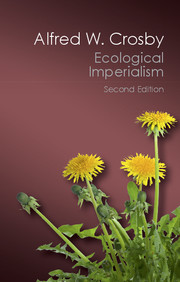Book contents
- Frontmatter
- Dedication
- Epigraph
- Contents
- List of Illustration
- Preface to the new edition
- Acknowledgments
- 1 Prologue
- 2 Pangaea revisited, the Neolithic reconsidered
- 3 The Norse and the Crusaders
- 4 The Fortunate Isles
- 5 Winds
- 6 Within reach, beyond grasp
- 7 Weeds
- 8 Animals
- 9 Ills
- 10 New Zealand
- 11 Explanations
- 12 Conclusion
- Appendix: What was the “smallpox” in New South Wales in 1789?
- Notes
- Index
Appendix: What was the “smallpox” in New South Wales in 1789?
Published online by Cambridge University Press: 05 October 2015
- Frontmatter
- Dedication
- Epigraph
- Contents
- List of Illustration
- Preface to the new edition
- Acknowledgments
- 1 Prologue
- 2 Pangaea revisited, the Neolithic reconsidered
- 3 The Norse and the Crusaders
- 4 The Fortunate Isles
- 5 Winds
- 6 Within reach, beyond grasp
- 7 Weeds
- 8 Animals
- 9 Ills
- 10 New Zealand
- 11 Explanations
- 12 Conclusion
- Appendix: What was the “smallpox” in New South Wales in 1789?
- Notes
- Index
Summary
The disease that struck the Australian Aborigines in 1789 was undoubtedly new to them, as evidenced by its impact upon them, and it seems unlikely that it had often raged in their continent before. But was it smallpox? Smallpox is a disease that combines virulence and extreme communicability and has no dormant state in humans or any other species – it can only rage, it cannot lurk. Even the virus living in the scabs from the pustules of its victims soon dies; there is nothing like a spore state. So the British must have brought it with them. But they could not have done so – not according to the record and what we know of the disease. There were no active cases of smallpox on board the First Fleet on the high seas, nor in the French ships that were cruising in the waters of New South Wales in 1789. In fact, the written record does not indicate any ship with the disease on board at or near New South Wales in 1788 or 1789. Ordinarily, such evidence, being purely negative, would not be worth much, but smallpox is such a frightful disease, and the Europeans in and around New South Wales at that time were so conscious of what devastation it could wreak, that it would be very odd, indeed, if one or more of them had it and no one thought to mention it in a letter, diary, or report.
None of the white settlers caught the disease, which is not surprising, because most likely they had all been immunized to this “childhood disease” back in Europe. But a number of white children had been born in Sydney, and none of these caught it either, despite the presence of Aborigines with active cases in the settlement. The only non-Aborigine who caught the disease in Sydney in 1789 was a seaman belonging to a visiting ship. He was – and this may be significant – an Amerindian from North America. He died of it.
Perhaps the disease was smallpox, but introduced by Malay seamen, visiting far northern Australia. Perhaps, but what a coincidence that they should bring smallpox just in time for it to meet the British on the beach, so to speak. Perhaps it was not smallpox, but chicken pox, a pustular disease with a dormant stage.
- Type
- Chapter
- Information
- Ecological ImperialismThe Biological Expansion of Europe, 900–1900, pp. 309 - 311Publisher: Cambridge University PressPrint publication year: 2015



